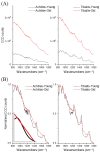Chemical Markers of Human Tendon Health Identified Using Raman Spectroscopy: Potential for In Vivo Assessment
- PMID: 36499181
- PMCID: PMC9737356
- DOI: 10.3390/ijms232314854
Chemical Markers of Human Tendon Health Identified Using Raman Spectroscopy: Potential for In Vivo Assessment
Abstract
The purpose of this study is to determine whether age-related changes to tendon matrix molecules can be detected using Raman spectroscopy. Raman spectra were collected from human Achilles (n = 8) and tibialis anterior (n = 8) tendon tissue excised from young (17 ± 3 years) and old (72 ± 7 years) age groups. Normalised Raman spectra underwent principal component analysis (PCA), to objectively identify differences between age groups and tendon types. Certain Raman band intensities were correlated with levels of advanced glycation end-product (AGE) collagen crosslinks, quantified using conventional destructive biochemistry techniques. Achilles and tibialis anterior tendons in the old age group demonstrated significantly higher overall Raman intensities and fluorescence levels compared to young tendons. PCA was able to distinguish young and old age groups and different tendon types. Raman intensities differed significantly for several bands, including those previously associated with AGE crosslinks, where a significant positive correlation with biochemical measures was demonstrated. Differences in Raman spectra between old and young tendon tissue and correlation with AGE crosslinks provides the basis for quantifying age-related chemical modifications to tendon matrix molecules in intact tissue. Our results suggest that Raman spectroscopy may provide a powerful tool to assess tendon health and vitality in the future.
Keywords: Achilles tendon; Raman spectroscopy; advanced glycation end-product; collagen crosslinks; extracellular matrix.
Conflict of interest statement
The authors declare no conflict of interest.
Figures





Similar articles
-
Detection of Age-Related Changes in Tendon Molecular Composition by Raman Spectroscopy-Potential for Rapid, Non-Invasive Assessment of Susceptibility to Injury.Int J Mol Sci. 2020 Mar 20;21(6):2150. doi: 10.3390/ijms21062150. Int J Mol Sci. 2020. PMID: 32245089 Free PMC article.
-
In vivo confocal Raman spectroscopic imaging of the human skin extracellular matrix degradation due to accumulated intrinsic and extrinsic aging.Photodermatol Photoimmunol Photomed. 2021 Mar;37(2):140-152. doi: 10.1111/phpp.12623. Epub 2020 Nov 9. Photodermatol Photoimmunol Photomed. 2021. PMID: 33095927
-
Human Achilles tendon mechanical behavior is more strongly related to collagen disorganization than advanced glycation end-products content.Sci Rep. 2021 Dec 17;11(1):24147. doi: 10.1038/s41598-021-03574-4. Sci Rep. 2021. PMID: 34921194 Free PMC article.
-
The role of vasculature and angiogenesis for the pathogenesis of degenerative tendons disease.Scand J Med Sci Sports. 2005 Aug;15(4):211-22. doi: 10.1111/j.1600-0838.2005.00465.x. Scand J Med Sci Sports. 2005. PMID: 15998338 Review.
-
Regulators of collagen crosslinking in developing and adult tendons.Eur Cell Mater. 2022 Apr 5;43:130-152. doi: 10.22203/eCM.v043a11. Eur Cell Mater. 2022. PMID: 35380167 Free PMC article. Review.
References
-
- Thorpe C.T., Streeter I., Pinchbeck G.L., Goodship A.E., Clegg P.D., Birch H.L. Aspartic acid racemization and collagen degradation markers reveal an accumulation of damage in tendon collagen that is enhanced with aging. J. Biol. Chem. 2010;285:15674–15681. doi: 10.1074/jbc.M109.077503. - DOI - PMC - PubMed
MeSH terms
Substances
LinkOut - more resources
Full Text Sources

